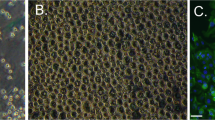Abstract
An acidic luminal pH (ref. 1–3) is involved in sperm maturation, and in maintaining sperm in an immotile state in the epididymis and vas deferens2,4–6. Neutralization by prostatic fluid is one of a complex series of events that triggers sperm motility2,7,8. Failure of the acidification mechanism might, therefore, result in poor sperm maturation, premature motility and infertility. We have shown that a vacuolar (H+)–ATPase is expressed at high levels on the luminal plasma membrane of specialized cells in the epididymis9, which closely resemble acid–secreting kidney intercalated cells10,11. We now show that similar cells are also present in the vas deferens, and that a bafilomycin–sensitive proton flux can be detected using a noninvasive proton–selective vibrating probe. Up to 80% of the net proton secretion in the vas deferens is inhibited by bafilomycin, consistent with a major role of a vacuolar–type (H+)–ATPase in this process. This acidification mechanism is a potential target for novel strategies aimed at modulating the acidification capacity of parts of the male reproductive tract and, therefore, in regulating male fertility.
This is a preview of subscription content, access via your institution
Access options
Subscribe to this journal
Receive 12 print issues and online access
$209.00 per year
only $17.42 per issue
Buy this article
- Purchase on Springer Link
- Instant access to full article PDF
Prices may be subject to local taxes which are calculated during checkout
Similar content being viewed by others
References
Caflisch, C.R. & DuBose, T.DJ. Direct evaluation of acidification by rat testis and epididymis: role of carbonic anhydrase. Am. J. Physiol. 258, E143E150 (1990).
Carr, W.D., Usselman, M.C. & Acott, T.S. Effect of pH, lactate, and viscoelastic drag on sperm motility: A species comparison. Biol Reprod. 33, 588–595 (1985).
Levine, N. & Kelly, H. Measurement of pH in the rat epididymis in vivo. J. Reprod. Fertil. 52, 333–335 (1978).
Hinton, B.T. & Palladino, M.A. Epididymal epithelium: Its contribution to the formation of a luminal fluid microenvironment. Microsc. Res. Tech. 30, 67–81 (1995).
Usselman, M.C. & Cone, R.A. Rat sperm are mechanically immobilized in the caudal epididymis by "immobilin", a high molecular weight glycoprotein. Biol. Reprod. 29, 1241–1253 (1983).
Wong, P.Y., Tsang, A.Y. & Lee, W.M. Effect of intraluminal ion concentrations on the secretion of the rat cauda epididymidis in vivo. Pflugers Arch. 387, 61–66 (1980).
Acott, T.S. & Carr, D.W. Inhibition of bovine spermatozoa by caudal epididymal fluid. II. Interaction of pH and a quiescence factor. Biol. Reprod. 30, 926–935 (1984).
Carr, D.W. & Acott, T.S. Intracellular pH regulates bovine sperm motility and protein phosphorylation. Biol Reprod. 41, 907–920 (1989).
Brown, D., Lui, B., Gluck, S. & Sabolic, I. A plasma membrane proton ATPase in specialized cells of rat epididymis. Am. J. Physiol. 263, C913C916 (1992).
Brown, D., Hirsch, S. & Gluck, S. Localization of a proton-pumping ATPase in rat kidney. J. Clin. Invest. 82, 2114–2126 (1988).
Brown, D., Hirsch, S. & Gluck, S., H+-ATPase is present in opposite plasma membrane domains in kidney epithelial cell subpopulations. Nature 331, 622–624 (1988).
Au, C.L. & Wong, P.Y. Luminal acidification by the perfused rat cauda epididymidis. J. Physiol. (Lond.) 309, 419–427 (1980).
Cohen, J.P., Hoffer, A.P. & Rosen, S. Carbonic anhydrase localization in the epididymis and testis of the rat: Histochemical and biochemical analysis. Biol. Reprod. 14, 339–346 (1976).
Ekstedt, E., Ridderstrale, Y., Ploen, L. & Rodriguez-Martinez, H. Histochemical localization of carbonic anhydrase in the testis and epididymis of the boar. Acta Anat. 141, 257–261 (1991).
Ekstedt, E. & Ridderstrale, Y. Histochemical localization of carbonic anhydrase in the testis and epididymis of the rabbit. Acta Anat. 143, 258–264 (1992).
Kaunisto, K. et al. Expression of carbonic anhydrase isoenzymes IV and II in rat epididymal duct. Biol. Reprod. 52, 1350–1357 (1995).
Lewis, S.E., Erickson, R.P., Barnett, L.B., Venta, P.J. & Tashian, R.E. N-Ethyl-nitrosourea-induced null mutation at the mouse Car-2 locus: An animal model for human carbonic anhydrase II deficiency syndrome. Proc. Natl. Acad. Sci. USA 85, 1962–1966 (1988).
Steinmetz, P.R. Cellular organization of urinary acidification. Am. J. Physiol. 251, F173F187 (1986).
Al-Awqati, Q. Regulation of membrane transport by endocytotic removal and exocytotic insertion of transporters. Methods Enzymol 172, 49–59 (1989).
Schuster, V.L. Function and regulation of collecting duct intercalated cells. Annu. Rev. Physiol. 55, 267–288 (1993).
Cohen, E.P. et al. Absence of H+-ATPase in cortical collecting tubules of a patient with Sjögren's syndrome and distal renal tubular acidosis. J. Am. Soc. Nephrol 3, 264–271 (1992).
Sly, W.S., Whyte, M.P., Krupin, T. & Sundaram, V. Positive renal response to intravenous acetazolamide in patients with carbonic anhydrase II deficiency. Pediatr. Res. 19, 1033–1036 (1985).
Smith, P.J.S., Sanger, R.H. & Jaffe, L.F. The vibrating Ca2+ electrode: A new technique for detecting plasma membrane regions of Ca2+ influx and efflux. Methods Cell Biol 40, 115–134 (1994).
Author information
Authors and Affiliations
Rights and permissions
About this article
Cite this article
Breton, S., Smith, P., Lui, B. et al. Acidification of the male reproductive tract by a proton pumping(H+)-ATPase. Nat Med 2, 470–472 (1996). https://doi.org/10.1038/nm0496-470
Received:
Accepted:
Issue Date:
DOI: https://doi.org/10.1038/nm0496-470
This article is cited by
-
Transcriptomic profile comparison reveals conservation of ionocytes across multiple organs
Scientific Reports (2023)
-
Arresting calcium-regulated sperm metabolic dynamics enables prolonged fertility in poultry liquid semen storage
Scientific Reports (2023)
-
Investigation of epididymal proteins and general sperm membrane characteristics of Formosan pangolin (Manis pentadactyla pentadactyla)
BMC Zoology (2020)
-
Pattern of protein expression in the epididymis of Oligoryzomys nigripes (Cricetidae, Sigmodontinae)
Cell and Tissue Research (2018)
-
In vitro and in vivo aphrodisiac properties of the seed extract from Allium tuberosum on corpus cavernosum smooth muscle relaxation and sexual behavior parameters in male Wistar rats
BMC Complementary and Alternative Medicine (2017)



